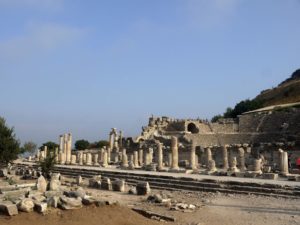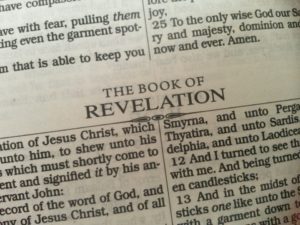“I know where you dwell, where Satan’s throne is. Yet you hold fast my name, and you did not deny my faith even in the days of Antipas my faithful witness, who was killed among you, where Satan dwells” (Revelation 2:13).
Pergamum was the capital of the Roman Province we now call Asia Minor. It was the centre of Empire, and had a temple dedicated to Aesculapius, the god of healing – represented by a snake – which may account for the phrase: ‘where Satan’s throne is’ (verse 13). Therefore,  the situation would have been very difficult for the Church there – as Christians were viewed with suspicion, for not submitting to the Emperor. So, how does Christ address them?
the situation would have been very difficult for the Church there – as Christians were viewed with suspicion, for not submitting to the Emperor. So, how does Christ address them?
The imagery of Jesus, ‘walking among the lampstands’, representing the Churches (1:20), tells us that the Lord knows all about them. He knows that things have been tough, but they have remained faithful, even during intense opposition (v2).[1] Yet, if they had been uncompromising in the past, some of them had done a 180 turn and gone to the other extreme! But, what exactly were they doing wrong?
For that, we need to take a trip back to the days of the Exodus. In Numbers, chapter 22-24 we meet Balaam. Balak, the King of Moab, was terrified that his kingdom would be overrun by the people of Israel. So, doing what you did in those days, he calls a prophet who, for a price, will curse them! Balaam obviously has a nice little side-line in doing this, but insists that he can only do so if God permits it. A memorable adventure with his ass follows, but Balaam disappoints Balak as he ends up blessing Israel! However, the story does not end there – Balaam wants it both ways. He wants his promised wage packet, so he finds another way, by encouraging the Moabite women to lure the men of Israel into sexual immorality (Numbers 31:16). He comes to a bad end (Numbers 31:8) and is sadly summed up as one ‘who loved to gain from wrongdoing’ (2 Peter 2:15).
So the Church was compromising. Like Balaam, they acted as if they were faithful to God. Yet in other areas they were anything but! Most likely some in the Church were saying they could be part of the city’s trade guilds, each of which had its own god and would have had meals where some of the food was sacrifice to an idol. No doubt these feasts would have  also encouraged immorality. Yet to get on in their particular jobs some Christians were convinced they could both serve God and participate in pagan revelry (v14)! If that was not bad enough, some of them were following the teaching of the dreaded Nicolatians.[2]
also encouraged immorality. Yet to get on in their particular jobs some Christians were convinced they could both serve God and participate in pagan revelry (v14)! If that was not bad enough, some of them were following the teaching of the dreaded Nicolatians.[2]
But Christ was having none of it! The two-edged sword John referred to in 1:16 is mentioned twice in this passage. In Hebrews 4:12-13 that metaphor is used to show the truth and the power of the Word of God. Quite simply Christ implies the message of the Gospel will cut the arguments of those guilty of this sin to pieces! The Church needed to repent for allowing this false teaching, which some had embraced (note: ‘them’ in v16), to have compromised the Church.
Nonetheless, Christ wants to bless his Church, with two promises: The ‘hidden manna’ probably refers to the manna that was kept in a jar during the Exodus – to remind future generations of God’s goodness to them (Exodus 16:33). This is later fulfilled in Christ in John 6:51 when Jesus says: ‘I am the living bread that came down from heaven. If anyone eats of this bread he will live for ever’. There are several possibilities as to what the ‘white stone’ symbolises. But one idea that appears most relevant here and makes most sense is the idea of the 12 stones that were on the breast plate of the high priest that had the names of the 12 tribes on them. This stone would have their: ‘new name’ on it, ensuring their inclusion among God’s people. Their future is assured, if they continue to be faithful by staying true to the Word of God. What a great incentive this is for us today not to compromise whatever the temptation!
Want to listen to a sermon on this passage? A Church that Tolerates False Teaching!
[1] Who was Antipas? Some commentators have linked him to various martyrs, but to be honest we just don’t know. It’s likely that he was a leader in the Church who had been faithful in the face of major opposition.
[2] The Nicolatians are mention here again, but Balaam may give us an indication about what they taught. The name Balaam means: ‘lord of the people’ and the word Nicolatians means: ‘to rule the people’ which suggests they could have been teaching some form of legalism which led to a ‘cast iron’ control of people. Warren Wiersbe, Be Victorious (Wheaton, SP Publications, 1985) 30.